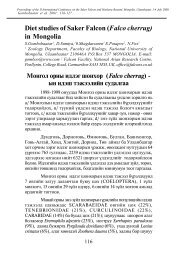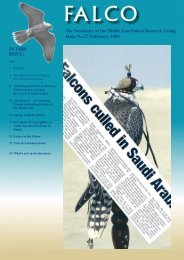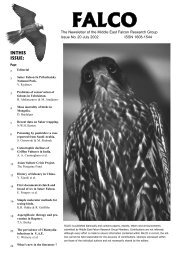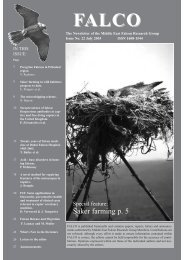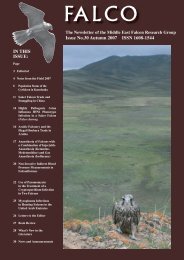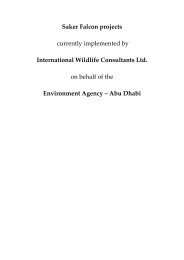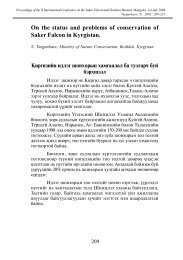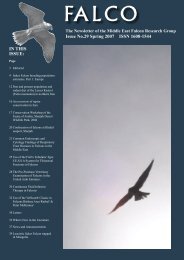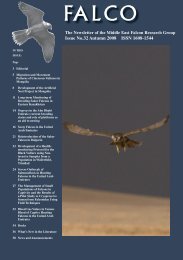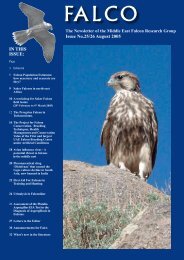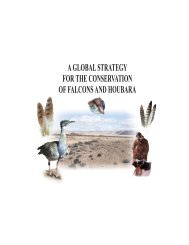Falco 28 - International Wildlife Consultants Ltd.
Falco 28 - International Wildlife Consultants Ltd.
Falco 28 - International Wildlife Consultants Ltd.
Create successful ePaper yourself
Turn your PDF publications into a flip-book with our unique Google optimized e-Paper software.
desert, steppe, forest, sub-alpine and alpine lands. The<br />
Meghri District is situated in the Siunik Region in<br />
the extreme southeast of Armenia (Figure 1). In the<br />
north and west, the border of Meghri passes through<br />
the watersheds of the Megrinskiy and Zangezurskiy<br />
mountain ridges and to the south it runs along the Araks<br />
River adjoining neighbouring Iran. The Meghri District<br />
is topographically distinct from other neighbouring<br />
districts in the Siunik Region, in that it is hilly with<br />
numerous rocky outcrops and much of the landscape<br />
can be classified as semi-desert.<br />
I undertook observations during seven expeditions to<br />
the Meghri District over the period 1996-98 and 2000-<br />
2002.<br />
Results and Discussion<br />
In the Meghri District the Peregrine <strong>Falco</strong>n breeds on<br />
rock faces in various landscape types, though the species<br />
does show a preference for open habitats: semi-desert<br />
and thin juniper forest. Based on our observations,<br />
we estimate that there are 7 to 9 pairs of Peregrine<br />
<strong>Falco</strong>ns breeding in the Meghri District and they are<br />
more abundant here than in other districts of Armenia<br />
primarily because of the availability of suitable nesting<br />
cliffs and rich food base. It is notable that in other parts<br />
of Armenia, Peregrine <strong>Falco</strong>ns have been recorded<br />
nesting in trees (Dal, 1954; Geilikman, 1987; Adamian<br />
& Klem, 1999) but in the Meghri District they nest<br />
exclusively in cliffs.<br />
Figure 2. Peregrine breeding habitat near Agarak<br />
In total I located six nesting sites. Two nests, within<br />
one breeding range, were situated in the vicinity of<br />
Agarak (Figure 2) and the other nests were found near<br />
Lehvaz, Meghri, Aldara and Shvanidzor. I also located<br />
two more pairs that were probably breeding on cliffs<br />
near of Karchevan and Nyuvadi settlements. The nests<br />
that I found were all situated in rock niches at heights<br />
of 20 to 100 m on steep or near vertical slopes, with an<br />
aspect facing east, north or west. The nearest neighbour<br />
distances between the seven pairs ranged from to 3.2-<br />
8.1 km, with an average of 5.86±0.62 km.<br />
In 1998, the Agarak pair moved about 1 km from their<br />
nesting site of the previous year probably because in<br />
that year a Griffon Vulture (Gyps fulvus) nested less<br />
than 40 m away from their eyrie. Five nests were<br />
located in rock niches with a height of 0.9 to 1.2 m, a<br />
width of 0.5 to 1 m and a depth of 1.0 to 2.0 m, whilst<br />
another was located on a sheltered cliff ledge. In some<br />
of the nesting niches there were the stick remains of old<br />
nests built by other species; one eyrie near Agarak was<br />
situated in the old nest of a Griffon Vulture.<br />
From our observations it appears that Peregrine <strong>Falco</strong>ns<br />
in the Meghri District begin egg laying in March. We<br />
observed Peregrines sitting on clutches until the 13 th<br />
April, and both sexes take part in incubation though the<br />
female undertakes the greater part. The male brought<br />
food for the incubating female one or two times a day.<br />
The female leaves the<br />
nest to collect the prey<br />
brought by her mate<br />
and to feed herself,<br />
and whilst she is so<br />
preoccupied the male sits<br />
on the eggs. Normally,<br />
when the female is<br />
incubating and the male<br />
is not hunting, he stands<br />
sentinel near the eyrie,<br />
though they normally<br />
only attack other<br />
passing raptors, such<br />
as Short-toed Eagles<br />
(Circaetus gallicus),<br />
Griffon Vultures and<br />
Golden Eagles (Aquila<br />
chrysaetos) when they<br />
encroach with 60 to 70<br />
m of the nest. It appears<br />
that adult Peregrines are<br />
more aggressive towards<br />
other raptors flying close<br />
their nest when they<br />
have older nestlings. I twice observed different pairs<br />
attack Golden Eagles flying about 500 m away from<br />
nests with older nestlings.



